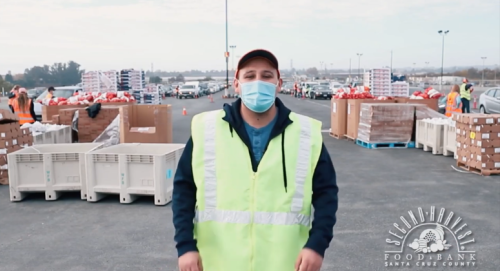UC Santa Cruz students, staff, and faculty contributed nearly $40,000 to the 2020 Holiday Food and Fund Drive sponsored by the Staff Advisory Board, enough to provide nearly 160,000 meals to local residents.
Each year the campus collects food and financial contributions for the Second Harvest Food Bank, founded in 1972 as the first food bank in California and second oldest in the nation. This year was particularly challenging and particularly successful given the extraordinary circumstances of a world-wide pandemic that resulted in the campus essentially emptying since March, said campus holiday food drive co-chair Nathan McCall.
“That is a remarkable amount of donations, especially considering we didn't have the typical amount from students donating their unused meals this year,” said McCall, manager of HR Business Information Services and SAB chair-elect, in a note to donors.
Need doubled last year
The campus’s increased giving will help the Food Bank meet the increased need for food from area residents which has doubled due to COVID’s effect on our community, he said.
UCSC donors contributed $39,748 which translates to 158,990 meals for the drive that began just after Thanksgiving and concluded just before the holiday break. The countywide drive continues through Jan. 15 with a goal of 4.5 million meals.
“We are very grateful for the generosity shown by the UC Santa Cruz Team,” said Jan Kamman, Second Harvest corporate and community relations director.
McCall thanked Chancellor Cynthia Larive and John Steele, his Holiday Food and Fund Drive co-chair, for their unwavering commitment to the drive. “Cindy has been so supportive,” McCall said, noting that the chancellor plans to become more involved with the countywide drive in the coming year.
“This has been an unprecedented time of need for our entire region,” Larive said. “I want to thank all of our campus affiliates for their generous contributions to the Holiday Food and Fund Drive, especially under these circumstances. Your consistent support for our neighbors is greatly appreciated. It truly was a season of giving.”
Food barrels are gone
Steele, past SAB chair, has been the longtime Holiday Food Drive chair, collecting hundreds of thousands of pounds of food. “John Steele did a fantastic job being the leader for over a decade,” McCall said. Different this year was the absence of the ubiquitous blue barrels across campus where contributors could donate cans and packages. This year and in the future the focus will be on funds rather than actual food.
Although the barrels provided a steady reminder of the food drive, McCalll said — and the food was welcome — the Food Bank can leverage financial contributions for even more food because of its relationships with local growers, food providers, and distributors.
“You can buy a can of beans for a dollar; the food bank can buy many pounds of beans with the same dollar,” he said, “because of their huge purchasing power.”
The Food Bank estimates it can provide four meals for every $1 donated. It sources more than 8 million pounds of food each year from farms, grocery stores, food manufacturers, distributors, and individuals, and distributes it to 100 food pantries, schools, soup kitchens, group homes, youth centers, and more, and another 100 Second Harvest program sites.
The Food Bank reaches 55,000 people a month. In November, it distributed more than 750,000 pounds of food to nearly 60,000 people. Almost 65 percent was distributed through non-profit partners. The rest was direct distribution to the community through the Food Bank’s nutrition programs and drive-through distribution sites in Watsonville and Santa Cruz.
Campus is a beneficiary
The UC Santa Cruz campus is also a Food Bank beneficiary. In 2019-2020, UCSC received 120,078 pounds of food from Second Harvest Food Bank including 31,683 pounds that went to Family Student Housing; 61,266 pounds distributed through Slug Support, and 27,129 pounds through the Student Union Assembly. Additionally, UCSC students and employees receive food resources from food distributions both on and off campus.
The Food Bank also helps UCSC students with applications to CalFresh, the state food access program for low-income residents, McCall said. The approval rate for applicants rose to 82 percent for 2019-2020 with the Food Bank’s help compared with a lower than 50 percent approval rate previously.



